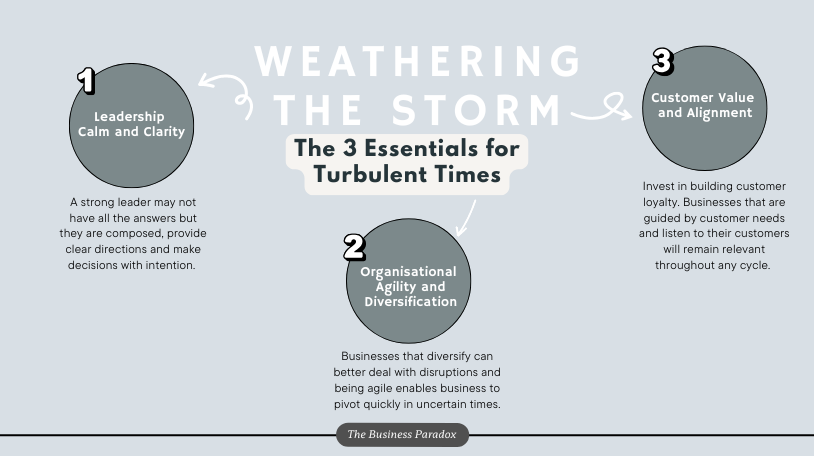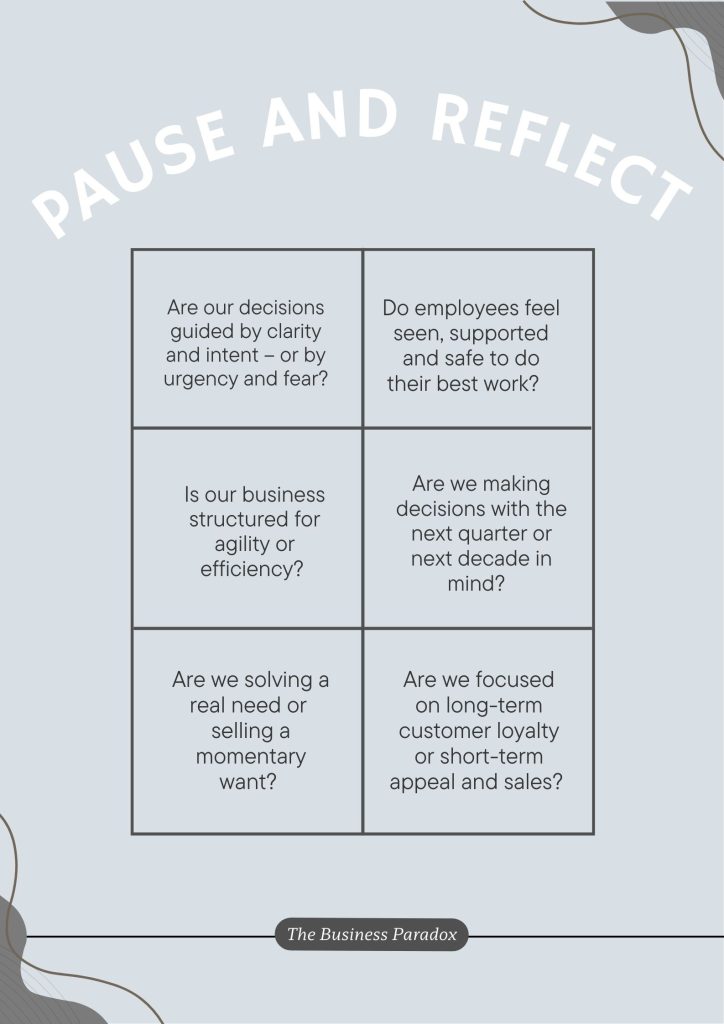Future-Proofing in an Uncertain World: Preparing for the Storm Before the Sun
Economic conditions are shifting rapidly, with rising operating costs, supply chain instability and unpredictable shifts in consumer demand across most industries. Globalisation has accelerated growth and expanded market access for many businesses, but it has also made businesses more susceptible to external shocks – where geopolitical tensions and policy changes such as trade tariffs can rapidly disrupt entire value chains. The interconnectedness of global markets means that disruptions in one region can reverberate worldwide, amplifying financial risk and strategic uncertainty. The global economy no longer moves in cycles of calm and chaos; instead, instability has become constant. In this context, the ability to lead with clarity and composure is a defining factor in long-term resilience.
This article explores three critical areas that leaders should focus on to future-proof their organisations in times of economic uncertainty. First, we examine the importance of leadership clarity and how the emotional posture of leadership directly shapes team culture and resilience. Next, we look at how businesses can structure themselves to withstand volatility by diversifying markets and risk exposure. Finally, we turn to value creation to ensure that products and services remain essential and relevant by staying aligned with evolving customer needs. Throughout this article, we offer reflection prompts to help leaders assess whether their organisations are equipped not just to weather the storm, but to emerge stronger when conditions improve.

Leadership Starts from Within
When the external environment becomes chaotic, internal regulation and strong leadership becomes non-negotiable. When leaders are anxious or reactive, it is easy for their teams to absorb and mirror those cues. In moments of heightened volatility, leaders must demonstrate focus, composure and intentionality in their decisions and their actions. The ability to model calm under pressure is a signal of control that stabilises the wider organisation. In doing so, leaders anchor their teams both operationally and emotionally, reinforcing the message that the business is grounded in purpose, not reacting from fear.
Economic instability impacts not only businesses themselves, but also the people within it. It creates a climate of uncertainty that permeates both professional roles and personal lives. In the workplace, this could manifest as psychological stress, burnout or fear-driven behaviour. Innovation shuts down when fear takes over. When employees are preoccupied with job security, they shift into survival mode, which limits their ability to problem-solve, collaborate or take creative risks. When leaders model calm, communicate transparently, and foster a culture of trust, they create the psychological safety necessary for employees to stay motivated and engaged even in turbulent times. In doing so, businesses don’t just endure economic crises, they build the internal strength and team cohesion that keeps them ahead of the curve.
Prompt for reflection:
Are our decisions guided by clarity and intent – or by urgency and fear? Do employees feel seen, supported and safe to do their best work?
Organise to Withstand, Plan to Adapt
To endure economic turbulence, businesses must resist the temptation to wait for stability to return before taking action. Instead, the focus should be on building resilience through diversification – spreading risk and expanding exposure across different markets, product lines and regions. This also means designing systems and processes that allow teams to remain steady under pressure and adapt quickly without becoming reactive. Businesses should diversify talent, capabilities, market exposure and decision-making structures. It is not about chasing every possible opportunity but building a balanced portfolio of revenue streams and operational capabilities that stabilise performance across varying conditions.
Yet, diversification alone is not going to be enough. Businesses need to build agility into their operations so they can shift course quickly when disruption occurs. Operational agility is increasingly dependent on the use of technology. Investing in tools like AI-driven forecasting, cloud-based inventory systems and integrated supply chain platforms can provide real time visibility, reduce costs and help leaders to respond faster and smarter. In turbulent times, these systems can mean the difference between being caught off guard and moving with precision. Forward-looking leaders that embed digital infrastructure into the organisation will be better equipped to manage uncertainty.
Prompt for reflection:
Is our business structured for agility or efficiency? Are we making decisions with the next quarter or next decade in mind?
Create Value with Clarity
As consumer habits shift in response to inflation, global conflict and market volatility, businesses must evolve while strengthening their core identity. In times of uncertainty, consumers gravitate toward stability, value and emotional resonance. This is not the time to overextend into risky markets or untested products, it’s the time to get clear on what you offer that still matters deeply to your customers. Brands that succeed during downturns are those that lead with strategic empathy – listening to their customers, providing consistent value and communicating clearly.
Consumers are likely to become more price-sensitive, seeking out products and services that are durable, emotionally affirming and aligned with their evolving priorities. Regular engagement keeps customers informed and connected with the brand, while emotional connections through storytelling foster trust and align with customer values. Businesses that closely monitor shifts in consumer preferences and sentiment can better align their offerings with market demands, helping them retain customer loyalty despite price increases. Earning and sustaining customer trust and loyalty can enable businesses to weather slow cycles and maintain stability when new growth is harder to achieve.
Prompt for reflection:
Are we solving a real need or selling a momentary want? Are we focused on long-term customer loyalty or short-term appeal and sales?
Conclusion: Ready for the Sunny Day
Storms don’t last forever. The dark clouds will pass. When the sun shines again, will your business be standing strong and ready to thrive? The real test is not just who survives – but who uses this time to build a stronger foundation. When the economy rebounds, it won’t be a reset – it will be a reorganisation. Leaders who can provide a grounded presence and consistent direction will help to stabilise teams amid chaos. A strong leader will be able to sustain team cohesion and empower employees to stay motivated, collaborative and solution focused, rather than retreating into fear, silence or internal competition.
The capacity to respond with clarity, integrity and innovation is what separates businesses that weather the storm from those that are swept away by it. The businesses that act with intention will be the ones standing tall when the sun breaks through. By leading with a clear vision, investing in team culture and realigning with customer behaviour, leaders can steer their business in the right direction. The real question is: Is your business positioned to spring forward when the opportunity returns?

Stay ahead with exclusive insights! Sign up for our mailing list and never miss an article. Be the first to discover inspiring stories, valuable insights and expert tips – straight to your inbox!




